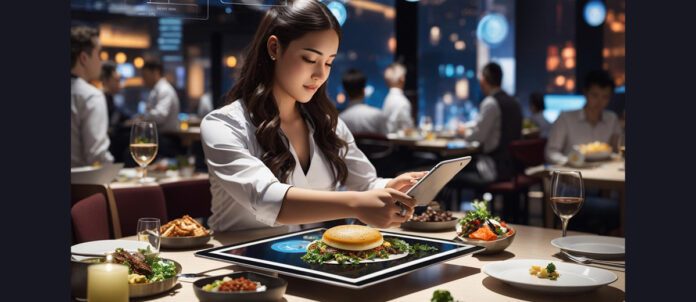By Mo Chaar
In an era of rapid digital transformation, the restaurant industry is harnessing technology to surmount challenges and adapt to shifting customer preferences. Artificial intelligence (AI) has recently started transforming the industry, with automated solutions such as AI-controlled kiosks becoming more commonplace. In today’s ever-changing hospitality landscape, restaurants must strive to retain their competitive edge, and operators risk losing out on crucial insights that can drive business growth if they lack the right technology stack.
A tech stack combines different software and systems to strengthen operational efficiency, manage operations and improve the customer experience. If seamlessly integrated, the right combination of programs will work in harmony to provide solutions tailored to specific aspects of restaurant operations, and a well-curated tech stack can determine the success of a restaurant’s ability to succeed and profit.
Building a Tech Stack
With a plethora of tech options at their disposal, restaurant owners often find themselves at a crossroads. In anticipation of an increasingly automated future, operators must first scrutinize their existing technology infrastructure, pinpointing areas ripe for enhancement. It’s important to set goals and determine the technology required to meet specific objectives. For instance, a common need is reservation management, and by moving reservation systems online, operators can see improved table and waitlist control. Establishing a functional restaurant tech stack relies heavily on the integration of various components. Most operators will already have a point-of-sale (POS) system in place, but a fully integrated POS system will help operators seamlessly connect with tech platforms already in use.
While the front- and back-of-house may have different needs, an integrated platform will streamline all levels of operations. For instance, with a kitchen display system (KDS), once a server inputs an order, it’s directed to the appropriate workstation in the kitchen. The KDS accurately measures cook times to ensure all meals are prepared and served simultaneously, streamlining work and making it easier for kitchen staff and servers alike. Ultimately, employee satisfaction leads to customer satisfaction, and dishes are less likely to be returned to the kitchen.
Lastly, as restaurants increasingly adopt advanced AI and automated technologies, prioritizing employee training becomes crucial. Training will equip staff members with the skills to operate and maintain these systems effectively and ensure a seamless transition. There will be an initial investment of both time and money when building a tech stack, but it’s important to remember that the payoff will be worthwhile.
Integrated Tech Stack Benefits
When investing in tech, operators should look to strike the right balance between customer, staff and business needs. One of the key objectives when building a tech stack is to enhance the guest experience by simplifying and optimizing restaurant operations. A significant benefit of an end-to-end POS system is the customer data it provides, such as buying trends and customer demographics. Restaurant owners can utilize this data to foster loyalty, deliver personalized promotions, analyze trends and enhance every facet of the customer journey.
We’re in the midst of an AI revolution, and restaurant operators are increasingly investing in AI technologies. For instance, DoorDash recently unveiled an AI-powered voice-ordering technology for restaurants that will provide customers with tailored recommendations to complement their meals. AI needs access to data to make curated suggestions, so in order to take advantage of AI technologies, restaurant operators must have a fully integrated tech stack in place, without obstacles such as data transfer between different software systems.
For dine-in guests, convenience reigns supreme. With contactless ordering and payment tools, customers can effortlessly browse menus, place orders and settle bills from their mobile devices by scanning a QR code.
However, as restaurants strive to create a seamless customer experience, it’s important to remember the vital role of human connection and empathy in nurturing a memorable dining experience. When building a tech stack, restaurant operators should consider implementing technology that will help to automate or increase the efficiency of tasks such as order and payment-taking. This technology will free up staff and give them more time to focus on fulfilling work such as guest interactions, ultimately helping to boost morale, provide exceptional customer service and drive productivity – a win-win-win for employees, guests and the business.
With abundant data, such as buying trends and customer demographics, operators can analyze it to identify trends and opportunities and make informed business decisions. For instance, operators can use this data to develop hyper-personalized loyalty programs. With a loyalty program in place, operators can increase customer retention, drive repeat business and increase spending to boost the bottom line.
Future-proofing the Restaurant
Restaurants are presented with an array of technological options. When building a tech stack, restaurants must symbiotically assess the needs of their staff, guests and the business. Using an end-to-end management platform with customizable integrations allows restaurants to house all their systems in one place for frictionless use, simplifying the restaurant experience with every interaction.
While the restaurant industry is innately intertwined with the human experience, automation can complement interpersonal communication by simplifying the backend and opening space for creative solutions. A viable tech stack succeeds by combining processes and integrating the tools that best suit each restaurant’s unique needs. Their application requires familiarity and practice, but their benefits are manifold. The hospitality industry will continue to face difficulties, but with a strong tech stack, operators will be well-equipped to overcome these challenges and thrive in the future.
Mo Chaar is the Chief Commercial Officer of Givex, a comprehensive platform that connects brands and customers through gift cards, loyalty programs, cloud-based POS, and ticketing solutions.


















